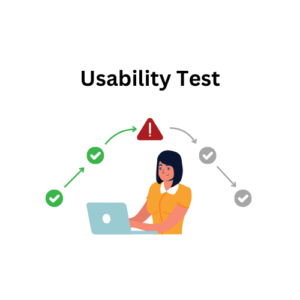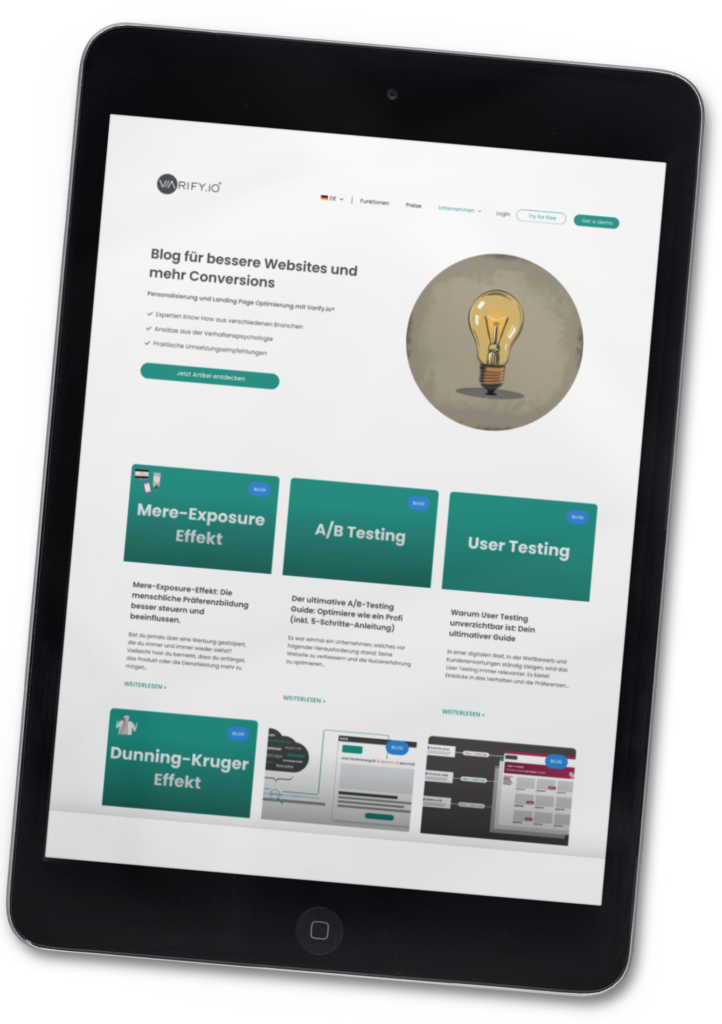Usability tests are the key to finding out how well a website is received by real users. They show where users have problems, how they navigate through the site and which elements need to be optimized. A targeted usability test helps to improve user-friendliness and increase conversion. But what concrete lessons can be learned from such a test?

Table of contents
What is a usability test?
A usability test is a method of checking the user-friendliness of a website. It involves testing a website with real users who are asked to perform certain tasks while their interactions are closely monitored. The aim is to uncover weaknesses in the design or user guidance that make it difficult for users to navigate or have a negative impact on the overall user experience.
What a usability test can reveal
Navigation
Analyzes whether users are efficiently guided through the product without getting lost or searching for information for an unnecessarily long time.
Hurdles
Reveals obstacles that prevent users from completing tasks effectively, such as complicated navigation or unclear instructions.
Structure
Helps to understand whether the arrangement of content is logical and easily accessible for users to find important information quickly.
Comprehensibility
Shows whether texts and information are formulated clearly and comprehensibly for the target group or whether adjustments are necessary to avoid misunderstandings.
Demolition
Identifies points at which users abandon the process and investigates which barriers lead to frustration or confusion.
Efficiency
Evaluates how quickly and effortlessly users can complete specific tasks, indicating the user-friendliness and efficiency of the interface.
Engagement
Measures how engaged users are in exploring and using the product, which indicates whether the design is motivating and appealing.
Satisfaction
Provides insights into whether users enjoy using the product and evoke positive emotions, which can lead to a higher reuse rate.
Methods of usability testing
There are various methods to help you carry out usability tests:
In Person Testing
With this method, users interact with the product directly on site while observers follow their behavior. This enables a deep understanding of user interactions, as the testers can provide immediate feedback and express their thoughts aloud.
Remote Testing
Users test the product in their familiar environment, while their interactions are often recorded via screen recording or webcam. Remote testing is flexible and cost-effective as it does not require physical presence and can reach a broad user base.
Card Sorting
This method is used to improve the information architecture of a product. Users organize content into categories that seem logical to them, which helps to develop user-friendly navigation.
A/B Testing
With A/B testing, two versions of a product are tested in parallel by splitting the traffic between the two versions. This method is ideal for determining which version performs better, for example in terms of conversion rates.
Thinking Aloud Tests
Users express their thoughts aloud while performing certain tasks in the product. This method provides valuable insights into user behavior and decision-making processes.
Eye tracking
Eye-tracking technology is used to track where users are looking on the screen. This method helps to analyze visual attention and determine which elements stand out or are overlooked.
How to prepare a usability test
The preparation of a usability test is crucial in order to achieve meaningful results. A structured approach ensures that the test can be carried out efficiently and that you gain the right insights. Here is a step-by-step guide to preparation:
1. target group definition
The first step is to precisely define the target group for the test. Who are the users of your website? What specific needs and challenges do they have? A clear target group definition helps to select the right testers that reflect actual user behavior.
2. selection of the right test methods and tools
Depending on your goals and target group, you need to choose the right test method. Is it a detailed analysis of user behavior (e.g. eye tracking), or do you want to get simple but quick feedback on the user interface (e.g. thinking aloud)? Choosing the right tools to carry out the test is also crucial - these include software solutions for screen recording, remote testing tools and analysis platforms.
3. creation of tasks and scenarios
To obtain valid results, the test tasks must reflect realistic scenarios that users would expect on the website. These tasks should not only include specific goals such as finding a product or completing a purchase, but also interactions that could reveal typical problems. Make sure that the tasks are clearly formulated and easy to carry out so that the test is as meaningful as possible.
4. checklist for the preparation of a usability test
A checklist will help you make sure you don't forget anything important. Here is a basic list that you can use for your preparation:
- Target group defined and participants recruited
- Test methods and tools selected
- Test tasks and scenarios prepared
- Procedure of the test defined (e.g. duration, number of tasks)
- Necessary devices and technologies provided (e.g. screen recording software, eye-tracking tools)
- Time scheduled for feedback and debriefing
Carrying out a usability test
Conducting a usability test is the central part of the process where you interact directly with users to gather valuable data. Here are some key factors you should consider in order to conduct an effective test:
1. exemplary test procedures
To carry out the test efficiently, you should plan a clear process. Start with a short introduction in which you explain to the users what they can expect without giving any hints about the design to be tested. The participants should carry out the tasks independently while you observe their interactions. It is important that you do not give direct instructions, but only offer assistance in case of problems. This helps to capture the authentic reactions of the users.
2. best practices for smooth test execution
Confidentiality and comfort: Make sure participants feel comfortable and safe by assuring the confidentiality of their data and not pressurizing them during the test.
Clear task definition: Make sure that the tasks are clearly formulated and that there are no unnecessary misunderstandings. You can ask users what they were thinking after each task.
Recording: Make sure that you record all relevant interactions, be it through screen recordings, video recordings or written notes. This will help you to carry out detailed analyses later on.
3. case study or expert opinion on the practical implementation of a test
A practical example or an expert opinion can help you to further refine the test procedure. In a case study, a company could describe how a specific usability test procedure has led to an improvement in the website. For example, an expert could point out common mistakes and how to avoid them in order to maximize the quality of the results.
Evaluation of the results
Evaluating the usability test results is crucial to understanding what insights you can draw from the test and how you can translate these into concrete optimizations. Here are the most important steps for analyzing and interpreting the test results:
1. analysis of the test results: Qualitative and quantitative
The evaluation of a usability test involves both qualitative and quantitative data. Qualitative data includes observations and user comments that provide valuable insights into the mindset and behavior of users. This data helps to identify design problems that are often not captured by pure numbers. Quantitative data, on the other hand, such as clicks, dwell time or success rates for tasks, provide measurable results and enable an objective analysis of user interactions.
2. important KPIs (Key Performance Indicators) for the success of a test
To evaluate the success of a usability test, you should define certain KPIs. The most common KPIs include:
- Task success rate: How many users have successfully completed the tasks?
- Error rate: How many mistakes did users make and what prevented them from completing their tasks correctly?
- Time spent per task: How long did users need to complete a task?
- Satisfaction: How satisfied are users with the user interface and interactions?
These KPIs help to objectively evaluate the user-friendliness and efficiency of the website.
3. graphics or diagrams to illustrate the evaluation
To present the results clearly and comprehensibly, it is often helpful to use graphics or diagrams. For example, you can create heat maps or diagrams showing the distribution of clicks and mouse movements. Such visualizations help to quickly grasp the key findings of the test and make well-founded decisions to optimize the website.
Conclusion: Why usability tests are indispensable
Usability tests are an indispensable tool for ensuring that websites are user-friendly, functional and effective. They make it possible to identify weak points in the design and derive concrete improvement measures that significantly optimize the user experience. In a world where user expectations are constantly rising, usability testing can make the difference between a successful and an unsuccessful website.
Regular usability tests not only improve the user experience, but also increase the conversion rate and long-term customer satisfaction. They also help to gain the trust of users by ensuring that the website meets their needs and expectations.
Integrate usability tests into your development process to continuously learn from real users and iteratively improve the website. This is the only way to ensure that your website not only looks good, but also works optimally for your target group.

